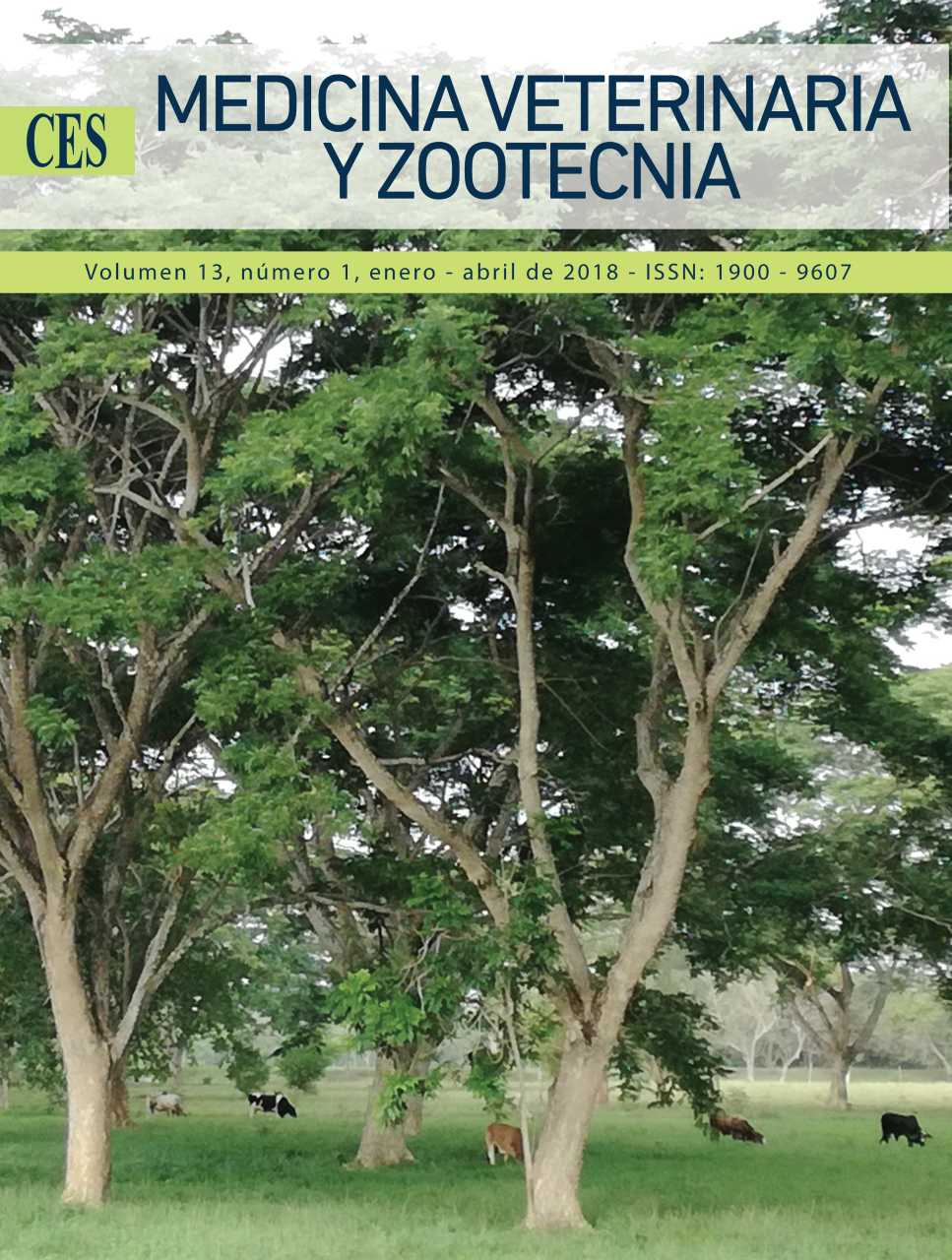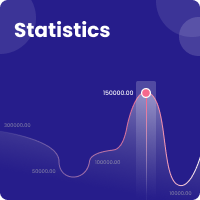Microorganisms isolated in bacteriological culture from milk samples from clinically healthy holstein cows
DOI:
https://doi.org/10.21615/cesmvz.13.1.3Abstract
Amicrobiological analysis was performed to determine the frequency of isolationof microorganisms of infectious and environmental type in milk from agroup of clinically healthy cows in two different types of milking (manual andmechanical). To each sample of milk was made bacteriological culture todetermine the presence of microorganisms. Of 289 milk samples evaluated,193 (66.78%) were positive for isolation of any type of pathogen, of which 81(28.02%) samples came from manual milking and 112 (38.75%) belonged tomechanical milking, finding a higher percentage of isolation of bacterial pathogensin milks coming from mechanical milking system (p = 0.0236). Themost isolated pathogen was the Arcanobacterium haemolyticum, A microorganismthat forms part of the saprophytic flora of the animal, with an individualpresence in 20.14% and in coinfection with other pathogens in 0.7%of the samples. The most common microorganism of subclinical mastitis incattle is Streptococcus agalactiae, which in the present study was isolatedfrom 12.50% of milk samples. The odds ratio (OR) between the isolation ofStreptococcus agalactiae and the Somatic Cell Score (SCS) was determined,which was statistically significant, indicating that when this pathogen is presentthe SCS increases and the animals are more susceptible to mastitis.
Downloads
References
Bonelli, S. B., Powell, R., Thompson, P. J., Yogarajah, M., Focke, N. K., Stretton, J., ... Koepp, M. J. (2011). Hippocampal activation correlates with visual confrontation naming: fMRI findings in controls and patients with temporal lobe epilepsy. Epilepsy research, 95(3), 246-254. doi: https://doi.org/10.1016/j.eplepsyres.2011.04.007
Caplan D., (2003). Aphasic Syndromes. In Heilman, M. K. M., & Valenstein, E. (Eds.). (2011). Clinical neuropsychology. Oxford University Press.
Cuetos-Vega, F., Arango-Lasprilla, J., Uribe-Pérez, C., Valencia-Marín, C., & Lopera-Restrepo, F. (2007). Linguistic Changes in verbal expression: a preclinical marker of Alzheimer’s Disease. Journal of the International Neuropsychological Society, 13, 433-439. doi: https://doi.org/10.1017/S1355617707070609
Dell, G., Chang, F., & Griffin, Z. (1999). Connectionist Models of Language Production: Lexical Access and Grammatical Encoding. Cognitive Science, 23(4), 517-542. doi: https://doi.org/10.1016/S0364-0213(99)00014-2
Dressel, K., Huber, W., Frings, L., Kümerer, D., Saur, D., Mader, I., … Abel, S. (2010). Model-oriented naming therapy in semantic dementia: A single-case fMRI study. Aphasiology, 24(12), 1537-1558. doi: https://doi.org/10.1080/02687038.2010.500567
Fernández-Blázquez, M. A., Ruiz-Sánchez de León, J. M., López-Pina, J. A., Llanero-Luque, M., Montenegro-Peña, M., & Montejo-Carrasco, P. (2012). Nueva versión reducida del test de denominación de Boston para mayores de 65años: aproximación desde la teoría de respuesta al ítem. Rev Neurol, 55, 399-407.
Fernández-Turrado, T., Tejero-Juste, C., Santos-Lasaosa, S., Pérez-Lázaro, C., Piñol-Ripoll, G., Mostacero-Miguel, E., & Pascual Millán, L. F. (2006). Lenguaje y deterioro cognitivo: un estudio semiológico en denominación visual. Rev Neurol, 42, 578-83.
Fridriksson, J. (2011). Measuring and inducing brain plasticity in chronic aphasia. Journal of communication disorders, 44(5), 557-563. doi: https://doi.org/10.1016/j.jcomdis.2011.04.009
Fridriksson, J., Morrow-Odom, L., Moser, D., Fridriksson, A., & Baylis, G. (2006). Neural recruitment associated with anomia treatment in aphasia. Neuroimage, 32(3), 1403-1412. doi: https://doi.org/10.1016/j.neuroimage.2006.04.194
Fridriksson, J., Moser, D., Bonilha, L., Morrow-Odom, K. L., Shaw, H., Fridriksson, A., ... Rorden, C. (2007). Neural correlates of phonological and semantic-based anomia treatment in aphasia. Neuropsychologia, 45(8), 1812-1822. doi: https://doi.org/10.1016/j.neuropsychologia.2006.12.017
Fridriksson, J., Richardson, J. D., Fillmore, P., & Cai, B. (2012). Left hemisphere plasticity and aphasia recovery. Neuroimage, 60(2), 854-863. doi: https://doi.org/10.1016/j.neuroimage.2011.12.057
Hoffmann, M., & Chen, R. (2013). The spectrum of aphasia subtypes and etiology in subacute stroke. Journal of Stroke and Cerebrovascular Diseases, 22(8), 1385-1392. doi: https://doi.org/10.1016/j.jstrokecerebrovasdis.2013.04.017
Kraft, A., Grimsen, C., Kehrer, S., Bahnemann, M., Spang, K., Prass, M., ... Brandt, S. A. (2012). Neurological and neuropsychological characteristics of occipital, occipito-temporal and occipito-parietal infarction. Cortex, 56, 38-50. doi: https://doi.org/10.1016/j.cortex.2012.10.004
Laganaro, M., Di Pietro, M., & Schnider, A. (2006). What does recovery from anomia tell us about the underlying impairment: The case of similar anomic patterns and different recovery. Neuropsychologia, 44(4), 534-545. doi: https://doi.org/10.1016/j.neuropsychologia.2005.07.005
Levac, D., Colquhoun, H., & O’Brien, K. (2010). Scoping studies: advancing the methodology. Implementation Science, 5(69). https://doi.org/10.1186/1748-5908-5-69
Lorenz, A., & Ziegler, W. (2009). Semantic vs. word-form specific techniques in anomia treatment: A multiple single-case study. Journal of Neurolinguistics, 22(6), 515-537. doi: https://doi.org/10.1016/j.jneuroling.2009.05.003
Martínez, E., Reyes-Saborit, A., Turtós-Carbonell, L., & Dusu-Contreras, R. (2014). Epidemiología de la afasia en Santiago de Cuba. Neurología Argentina, 6(2), 77-82. doi: https://doi.org/10.1016/j.neuarg.2013.12.002
Mesulam, M., Rogalski, E., Wieneke, C., Cobia, D., Rademaker, A., Thompson, C., & Weintraub, S. (2009). Neurology of anomia in the semantic variant of primary progressive aphasia. Brain, 132, 2553-2565. doi: https://doi.org/10.1093/brain/awp138
Montañés, P., & de Brigard, F. (2001). Neuropsicología clínica y cognoscitiva. Bogotá: Universidad Nacional de Colombia.
National Institute on Deafness and Other Communication Disorders. (2015). NIDCD fact sheet: Aphasia [PDF] [NIH Pub. No. 97-4257]. Retrieved from https://www.nidcd.nih.gov/sites/default/files/Documents/health/voice/Aphasia6-1-16.pdf
Neumann, Y., Obler, L., Gomes, H., & Shafer, V. (2009). Phonological vs sensory contributions to age effects in naming: An electophysiological study. Aphasiology, 23(7-8), 1028-1039. doi: https://doi.org/10.1080/02687030802661630
Pham, M. T., Rajic, A., Greig, J. D., Sargeant, J. M., Papadopoulos, A., & McEwen, S. A. (2014). A scoping review of scoping reviews: advancing the approach and enhancing the consistency. Research Synthesis Methods, 5, 371 – 385. doi: https://doi.org/10.1002/jrsm.1123
Rochon, E., Leonard, C., Burianova, H., Laird, L., Soros, P., Graham, S., & Grady, C. (2010). Neural changes after phonological treatment for anomia: An fMRI study. Brain & Language, 114, 164-179. doi: https://doi.org/10.1016/j.bandl.2010.05.005
Tuomiranta, L. M., Càmara, E., Froudist Walsh, S., Ripolles, P., Saunavaara, J. P., Parkkola, R., ... Laine, M. (2014). Hidden word learning capacity through orthography in aphasia. Cortex, 50, 174-191. doi: https://doi.org/10.1016/j.cortex.2013.10.003
Van Hees, S., McMahon, K., Angwin, A., de Zubicaray, G., & Copland, D. (2014). Neural activity associated with semantic versus phonological anomia treatments in aphasia. Brain & Language, 129, 47-57. doi: https://doi.org/10.1016/j.bandl.2013.12.004
Webb, W. (2017). Neurology for the Speech-Language Pathologist (Sixth edition). Missouri: Elsevier. doi: https://doi.org/10.1016/B978-0-323-10027-4.12001-9
Downloads
Published
How to Cite
Issue
Section
License
Copyright (c) 2018 CES Medicina Veterinaria y Zootecnia

This work is licensed under a Creative Commons Attribution-NonCommercial-ShareAlike 4.0 International License.
| Article metrics | |
|---|---|
| Abstract views | |
| Galley vies | |
| PDF Views | |
| HTML views | |
| Other views | |



